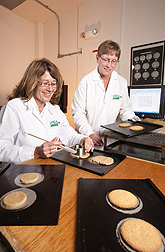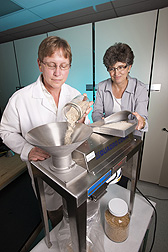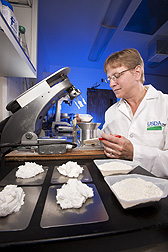Flour Power: Whole-Grain Flour Studies
May Help Boost the Goodness of Crackers and Cookies
For some of us, the fun of year-end holiday gatherings isn’t only the pleasure of being with friends and family.
It’s also the food.
Holiday hosts seem intent on making sure that we’re very well fed. Everywhere you turn, there’s a snack tray laden with tasty crackers and enticing dips. Plates of sweet treats—festive cookies, for example—are often within easy reach, too.
If Agricultural Research Service wheat quality researchers have their way, more recipes for crackers, cookies, and other baked goodies will call for a greater proportion of flour made from whole-grain wheat, in relation to the amount of familiar, highly refined white flour that’s used today.
“Americans don’t eat enough whole grains and don’t get enough dietary fiber,” says wheat expert Edward J. Souza. From Souza’s perspective, putting more whole-grain wheat flour into foods that people will buy and enjoy may be one way to help us get the whole grains and fiber we need.
Consumption of whole grains has, in some studies, been associated with reduced risk of cardiovascular disease, the number-one killer of Americans.
A former research leader and plant geneticist with ARS’s Soft Wheat Quality Laboratory in Wooster, Ohio, Souza now directs wheat breeding for an international plant science company.
The Wheat Kernel’s Three Key Components
A wheat kernel contains three key structural components: The outer, or bran, layer; the tiny wheat seed, also referred to as the “germ” or “embryo”; and the endosperm, which takes up most of the inside of a plump, ready-to-harvest kernel.
When the miller or baker wants all the grain components for a flour, the entire kernel is used. Flour that contains whole-grain components provides more fiber than traditionally milled white flours and also provides more magnesium—from the bran—which may be important for controlling diabetes and heart disease.
The bran contributes some additional minerals, including selenium, and B vitamins. The germ provides B vitamins too, along with vitamin E, small amounts of vitamins A and K, and healthful fats. The endosperm yields carbohydrates and protein.
At Wooster, Souza’s research focused on soft wheat—the kind that’s used for making crackers, cakes, cookies, breakfast bars, pancakes, waffles, flour tortillas, some kinds of snack chips, and more. That’s in contrast to, for instance, hard wheats, which bakers choose for making loaves of raised breads, or durum flours, which chefs worldwide use for pasta.
The Wooster team’s studies are filling in some of the gaps in our knowledge about whole-grain flours made from soft wheat. In recent research, for example, Souza and colleagues tackled the question of how much dietary fiber is really in today’s whole-grain soft-wheat flours. In other investigations, the researchers confirmed the value of two readily available laboratory tests that can help wheat breeders predict, early on, what kinds of promising new soft-wheat plants are the most likely to yield superior whole-grain flours for cookie doughs.
Dietary Fiber: New Estimates for Bakers, Shoppers, and Nutrition Researchers
Precisely how much dietary fiber is in soft-wheat whole-grain flour isn’t well known, according to Souza. “When we first began looking at information about the dietary fiber content of these flours,” he says, “we found very few measurements. Some were based on surprisingly small numbers of samples. Others were based on hard wheats, not soft. And others were derived from old, outdated analytical procedures.”
To help clarify this somewhat muddled picture, Souza and colleagues Mary J. Guttieri, a research specialist, and Clay H. Sneller, an associate professor, conducted what is perhaps the most comprehensive analysis to date of dietary fiber levels in a nationally representative sample of soft-wheat whole-grain flours.
Sneller is with Ohio State University’s Ohio Agricultural Research and Development Center in Wooster, and Guttieri was formerly with the center.
The team used a relatively new analytical method, variously known as the “McCleary method,” the “all-in-one test,” and the “CODEX fiber method.” They tested an impressive assortment of soft wheats from fields and flour mills across North America. For example, they acquired kernels from 13 different wheat-growing regions—from Virginia and South Carolina to Utah and Oregon—and then tested the dietary fiber levels of the whole-grain flours made from those kernels.
|
|
Approaching the sampling from another perspective, they studied five different kinds of commercial whole-grain soft-wheat flours, including some from mills in Utah and in Ontario, Canada, and from a natural foods store in Ohio.
To discover more about year-to-year variations, they compared flours from each of two different commercial wheats grown at each of two sites in Ohio during 3 consecutive years. “We wanted to take as many key factors into account as possible,” notes Souza.
The scientists determined that soft-wheat whole-grain flours have, on average, about 14.8 grams of dietary fiber in each 100 grams of flour. Though that’s only slightly higher than the most widely referred to U.S. estimate, it should nonetheless be of interest because of the scope of the study and the precision and accuracy of the analytical method used.
The findings were presented at the 2010 annual national meeting of the American Association of Cereal Chemists and will appear in an article accepted for Cereal Chemistry, a peer-reviewed journal.
Their estimate may be used in new editions of nutrition databases, sources that foodmakers may consult when preparing those nutrient data labels that you see on packaged foods. Health-conscious shoppers can check those labels in deciding which products are their best nutrition buy.
What’s more, dietitians and nutrition researchers might use the data when estimating how much dietary fiber we are (or aren’t) eating in America. Their analyses might, in turn, be used—along with other data from other sources—to shape future updates of the nation’s dietary guidelines.
Kraft Foods North America, General Mills, Inc., and Kellogg Co. funded the research, in addition to ARS.
Tomorrow’s Cookie Doughs: Which New Wheats Are Best?
The Wooster research also helps wheat breeders zero in on promising new wheat plants that might be tomorrow’s superstar producers of whole-grain wheat flours for cookie doughs. “Breeders of soft wheats usually work with thousands of candidate plants every year, keeping only the best for further tryouts,” according to Souza.
With research funding from ARS, Ohio State University, and Kraft Foods North America, Souza’s team provided new, detailed evidence to confirm that two readily available, inexpensive, and relatively simple tests are reliable tools for getting an early, in-the-laboratory indication of how good a new wheat may prove to be as a future source of whole-grain cookie flour.
One procedure, the sucrose SRC (solvent retention capacity) test, is an indication of the flour’s ability to absorb and hold water. “For cookies that are tender, not tough, you want a low SRC score,” Souza notes.
In the milling softness equivalent test, quantity is the key. “The more flour produced in the first few passes through a milling device,” he says, “the better the quality of the cookie.”
The tests aren’t new. They are already used at wheat quality labs across the country to evaluate candidate wheats for white-flour products. But the Wooster team’s study is perhaps the most thorough examination of the two tests’ reliability as an early screen for a new soft-wheat flour’s performance in whole-grain cookie doughs.
“We used 14 different commercial varieties of winter-planted soft wheat for this study,” comments Souza. The wheats were grown at two different locations in Ohio in 2007 and in 2008.
To prove the value of the two assays, the scientists needed to determine how closely results from those tests correlated with the whole-grain flour’s performance in a more expensive—and elaborate—procedure known as the “wire-cut cookie test.”
This well-established baking test gets its name from the strong, thin wire that slices the dough into cookies, readying them for big baking trays.
“We showed that breeders and foodmakers can rely on the SRC and softness tests for early screening. Later, when they want to narrow their focus to only those plants that are uniquely superior sources of whole-grain cookie dough flour, they can invest in the wire-cut cookie test,” Souza explains.
Of course, this phase of the research required baking dozens of cookies. The best flours make big, tender cookies, which is exactly what bakers—and millions of cookie fans everywhere—want them to do.
Souza, Guttieri, and Sneller published their findings earlier this year in a peer-reviewed article in Crop Science.—By Marcia Wood, Agricultural Research Service Information Staff.
This research supports the USDA priority of promoting food security and is part of Quality and Utilization of Agricultural Products, an ARS national program (#306) described at www.nps.ars.usda.gov.
To reach the scientists featured in this article, contact Marcia Wood, USDA-ARS Information Staff, 5601 Sunnyside Ave., Beltsville, MD 20705-5129; (301) 504-1662.
"Flour Power: Whole-Grain Flour Studies May Help Boost the Goodness of Crackers and Cookies" was published in the November/December 2011 issue of Agricultural Research magazine.










